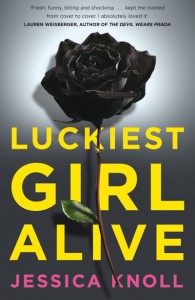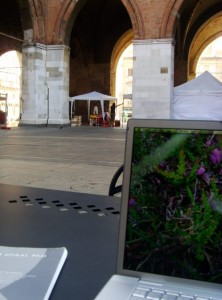Earlier this month US Glamour magazine had a Two Bags Of Sand moment. You remember the scene in The 40 Year Old Virgin when the guys are all sitting around with a takeaway talking about their sexual experiences and Steve Carell’s character says “yeah, her breasts were like, um, two bags of sand…”
It’s the moment everyone around the table realises that he’s faking it, that he has no idea what he’s talking about. And when Glamour’s website published it’s 13 little things that can make a man fall hard for you, including such gems as “make him a sandwich after sex” and “answer the door in a negligee” something similar happened. Everyone stopped eating their pizza and stared. The entire source of a magazine’s power lies in its ability to convince its readers, advertisers and critics that it knows best and for a moment that effortless glossy facade dropped to reveal the magazine’s inner workings – a legion of tiny tired journalists searching desperately for something new to say about sex and relationships.
As someone who worked for years on women’s magazines I read the whole thing through my fingers, cringing in horror and the mockery that followed was richly deserved. But then came the usual parade of accusations, that women’s magazines were dated and woefully out of touch. Several listicles appeared online poking fun at the sex tips magazines have offered over the years (the one about ‘teasing’ your partner’s testicles with a fork was a particular humdinger). And the message – usually from online sources that like to consider themselves edgier than old fashioned paper – is that women’s magazines are dated and woefully out of touch.
We have found our clitoris and we’re not afraid to use it.
Maybe they’re right. Maybe women’s magazines should stop talking about sex altogether.
Back in the 1970s and 80s we needed that sort of thing. Without magazines, and the occasional surreptitious look at Judy Bloom’s Forever, the only self proclaimed experts on sex were men. And where did men get their sex tips? The glorious world of 70s porn.
Of course we live in much more liberated times now. In the post Sex & The City generation women know they can expect more in bed. We have found our clitoris and we’re not afraid to use it. And there is an endless range of sources for reliable sex tips out there.
Isn’t there?
There’s the sex toy companies. After all every self respecting girl has a Rampant Rabbit or two tucked away in her bedside drawer. Although obviously the sex toy companies have a bit of a vested interest in selling you sex toys.
Or there’s erotic literature… because 50 Shades Of Grey is a perfect how-to handbook of sexy but responsible BDSM play isn’t it? It isn’t? Oh.
Then there’s our mates – but then we’re back in two bags of sand territory. According to research by Rachel Hills the author of The Sex Myth we’re all lying about how much sex we have and how creative we are when we’re doing it. No reliable information there, then.
Of course when we want to know something these days we Google it. There are some fabulous female friendly sex sites out there providing full, frank and funny discussions about love and sex – Em and Lo and Nerve for instance. But without knowing where to look it’s hard to get started – Googling sex questions can bring up a terrifying selection of misleading, unhealthy or eye-burningly horrid search results.
Which brings us right back to the source of all sex-inspiration: porn. Since the 70s skin-flicks have morphed into a monstrous, ever present stream of hard core which many young men have come to think of as ‘normal sex’. A while back I had coffee with an agony aunt who said a huge proportion of mail in her inbox was from young women who were worried there was something wrong with them because they didn’t enjoy anal sex.
So maybe women’s magazines do have a role after all.
In the 70s and after, women’s mags taught us that it was OK to enjoy sex – that we weren’t wanton hussies for liking it on top, or asking for oral or wanting to be good at it (because pleasing your partner is a part of sex for men and women alike.) It paved the way for splendid Samantha in Sex & The City and a generation of witty and honest sex bloggers.
The features that did really well were the ones that rang funny and true
I came to women’s glossies in the early 2000s when things started to change. In The Sex Myth Rachel Hills talks about that feeling of inadequacy if you feel uncomfortable sexting or don’t like doggy style. The feeling that everyone else is having a better time than you. And it’s up to women’s mags to burst that bubble… But without making the sexting doggy-fans feel like they’re being slut-shamed somehow. Tricky, huh?
For us, the features that did really well were the ones that rang funny and true. Like the hilarious takedown one of our writers did of some of the crazier sex toys on the market. Or the horrible consequences of When dirty talk goes wrong (Quote: “I’m the drill baby, and you’re the road…”) Or the sweet and sad piece Brooke Magnati, aka Belle De Jour, wrote for us on When the sex is great but everything else sucks. They were conversation starters, got us thinking about what we really wanted and showed us that everyone makes mistakes.
That’s the kind of sex article that women’s mags do best – funny frank and reassuring. And there’s a lot of that out there. There are also campaigns for women’s rights, and sharp, insightful reports on the things which threaten our relationships – like porn addiction.
There’s still a role for how-to tips too. I figure that sex tips are like magazine recipes – a source of ideas that you can take or leave. You might see a recipe for chicken soup, read it and appreciate it but never get round to making it. You could leave out the cream and pepper or just decide your own formula is best. And if you don’t like chicken at all? Not a problem, there’s a carrot and coriander number on the next page. The message is not “do this” but, “you might like to try this, and if it doesn’t work at least it’ll be a giggle.”
Whatever the magazines might claim, they’re not all knowing and all seeing. They can’t give you guaranteed moves when every body is so different and sometimes they do get it wrong. But they’re more realistic than 50 Shades, more reliable than your best mate and funnier than porn. Just one more source of advice and inspiration to help you make the most of your relationships. Take it or leave it.

 So chances are you won’t love TifAni. But you’ll sit up all night reading to find out what happened to her, whether she’ll get the wedding she deserves and who she decides to be in the end.
So chances are you won’t love TifAni. But you’ll sit up all night reading to find out what happened to her, whether she’ll get the wedding she deserves and who she decides to be in the end.



